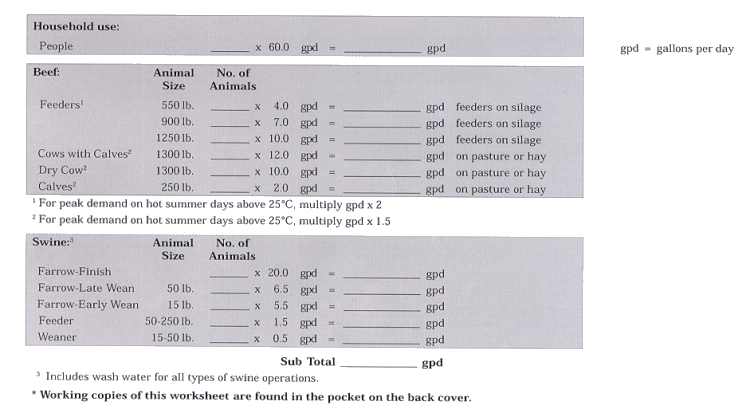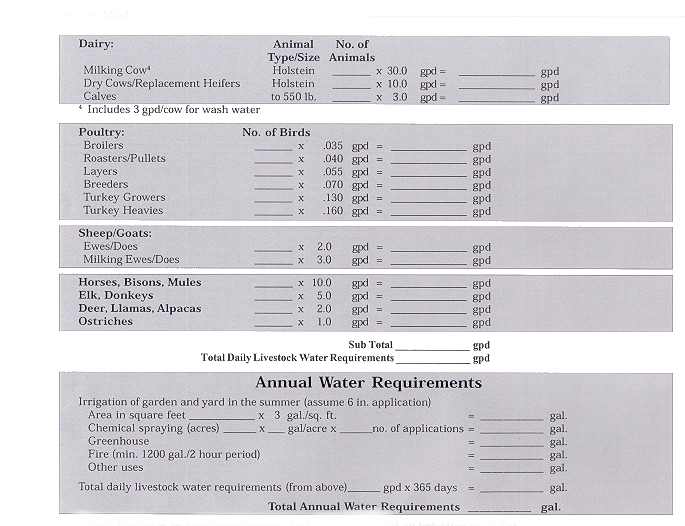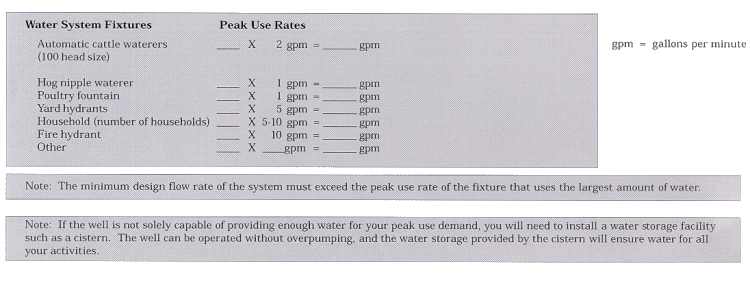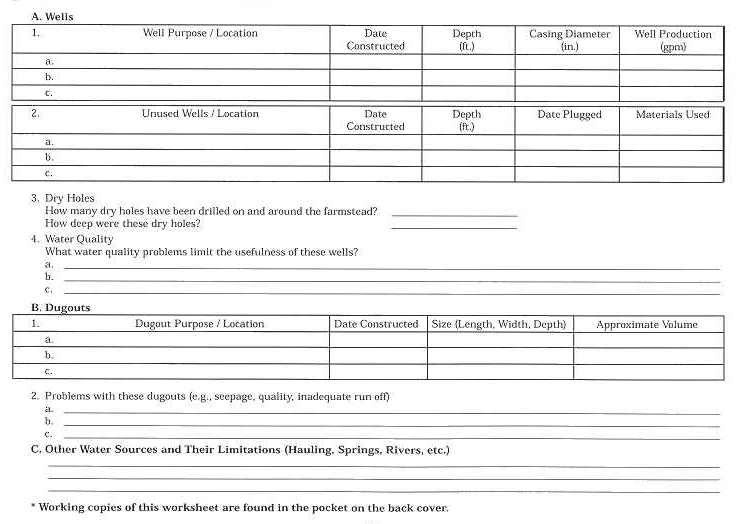| | Why plan | Steps to planning your water system | Water source options wells | Other planning considerations | Worksheet - Average daily and annual water requirements | Worksheet - Sizing of water systems | Worksheet - Farm water supply inventory | Average daily and annual water requirements calculator
This module helps you assess whether your water source has adequate capacity to meet your needs. Water sources are covered in detail. You will also get an overview of the planning considerations and benefits of a well-designed water system. A water system may include:
- Water sources
- Pumps
- Pressure system and additional storage if required
- Distribution system including pipelines, automatic waterers, hydrants and home plumbing
- WWater treatment equipment.
For more specific information on pumps, pressure tanks, pipeline sizing, water quality and treatment equipment, contact a water specialist with Alberta Agriculture and Rural Development. You could also contact the Alberta Water Well Drilling Association or your local licensed water well contractors. See Module 11 "Contacts for
More Information".
You should determine water quality and availability before you buy a new property or build a new home. If there is an existing well, you should have it yield tested to establish its performance. You should also have the water tested for quality.
|
Why Plan?
Often little thought and foresight are given to planning a farm or home water system. On the surface, a water system seems no more than an automatic pump and storage tank that delivers water under pressure to the household. There are other important aspects, such as how much water is available, the pressure requirements, water quality and provisions for watering a garden and fire fighting. When planning your water system, consider all the uses (current and potential) of water in your home and business. Include such things as:
- Livestock watering
- Cleaning barn floors and equipment
- Irrigation of gardens and greenhouses
- Egg and milk production
- FFire protection.
A water system that is well planned and designed costs more initially but saves money in the end. Costly changes to correct errors are reduced and you have a convenient and reliable water supply, provided you monitor and maintain the system (see Module 5 "Monitoring & Maintenance of Your Water Well" and Module 6 "Shock Chlorination").
Steps to Planning Your Water System
In order to plan your water system you need to:
- Determine water requirements
- Complete an inventory of water sources.
Determine Water Requirements
The first step to planning is to determine your water requirements. Look beyond your current requirements and consider any changes you may be making in the next few years. For example, is another family moving to the farm? Are you considering diversifying to include a market garden? Use the worksheets "Daily and Annual Water Requirements" and "Sizing of Water Systems" included in the pocket on the back cover to calculate your daily, annual and peak use requirements. Sample copies are at the back of the module.
Complete an Inventory of Water Sources
The next step to planning is to complete an inventory of all existing well and surface water sources. Record production rates, storage volumes and any previous problems with water quantity or quality for each water source. Completing an inventory will show if there is adequate water supply to meet your needs year round. Use the worksheet, "Farm Water Supply Inventory," included in the back cover pocket to list all the water sources available to you.
A well-planned water system should also have a backup or second water source in case of pump or water source failure. Water sources that can easily be connected using underground piping provide the flexibility required in emergencies. If you have some doubt about the adequacy of your existing water sources, take time to check all the options before choosing to drill a new well. There may be ways of increasing well yields or water storage to meet your needs. In some situations a well can comfortably keep up to daily requirements but not peak demands. The addition of a cistern with one-half to one day storage may be all that is required.
Contact Alberta Environment and Sustainable Resource Development’s Groundwater Information Centre at 780-427-2770 for water well drilling reports. In some counties, you may also have access to groundwater maps and reports. Contact
your local county or MD office, or the Alberta Government Library. See Module 12 "Other Resources". |
Water Source Options Wells
Water wells are generally the first choice of Albertans wherever there is an adequate supply of good groundwater. In areas of marginal groundwater supply, livestock operations often use a combination of wells and dugouts. The better quality water from the well usually
supplies the household and may supplement the livestock’s requirements. For most household situations, wells with a production rate of less than 5 gallons per minute (gpm) for a one hour (peak use) period do not supply enough water so it is usually necessary to create additional water storage using a tank or cistern. Wells that produce at a 5-10 gpm rate usually do not require additional storage.
When a lot of demand is placed on the well at any given time it should be capable of providing a minimum of 10 gpm for at least 2 continuous hours. If the flow rate of the well falls short of this amount, a cistern is usually the best option for providing water storage,
to overcome the shortage of water. For livestock operations, a well should be capable of providing all of the water requirements in an 8 to 12 hour period.
| A well that produces as little as 0.5 gpm can meet average household needs for most Alberta families if the water is pumped into a cistern and stored for peak use times. |
Dugouts
In areas where there is either poor groundwater supply or quality, dugouts may be used exclusively, or in combination with a well, as a water source. If you need to rely solely on a dugout for your water, size the dugout for a two to three year supply. Over this period, the dugout will be filled from runoff or an irrigation canal. When you plan the dugout, be sure to:
- Locate the dugout upstream of any livestock areas or other sources of contamination
- Fence the dugout
- Install a pumping system with a floating intake
- Aerate.
If you have a well and dugout, it is recommended that you use the well water for household use because it is typically of better quality. Dugouts can provide a good quality water source for livestock and irrigation purposes. Check dugout water quality and be aware of risks of algae, etc.
| The publication "Quality Farm Dugouts" provides information on design, maintenance and management of a dugout. For more information on using and treating dugout water for household and livestock use, see Module 12 "Other Resources" for a list of publications. |
Other Planning Considerations
No matter the water source, do the following to protect your water supply:
- Test the water quality regularly
- Treat the water if necessary
- Monitor the supply and water level
- Maintain the well and water system
- Protect the water source from contamination.
Test Water Quality
All farm water sources should be tested when the supply is first connected and continually tested on a regular basis. Test the water more often if you notice a significant change in the water quality, if a toxic spill occurs nearby, or if a change occurs in land use or activity. A thorough chemical and bacteriological analysis of water for household use can be done through your local health unit. Water samples for agricultural purposes can be taken to private labs for testing. These labs will supply sample bottles and correct procedures for sampling. For more information on testing water quality, see Module 5 ”Monitoring and Maintenance of Your Well”.
| Be sure to keep all records of water quality tests for future reference and monitoring |
Treat water
Water quality tests will point out any problems that need to be corrected. Wells may become contaminated with harmful bacteria, parasites or viruses. Nuisance bacteria, although not harmful, are a common well water problem in Alberta. The water may have a poor taste, odour or colour, or be high in total dissolved solids (TDS). Treatments for these and other problems may include disinfection, special filters, water softeners or distillation.
For more details on specific water treatments see Module 7 "Troubleshooting Water Well
Problems" and Module 12 "Other Resources". |
Monitor the supply
Monitoring your water sources is an important step to ensuring a lasting water supply. It can be compared to checking the oil in a vehicle or doing soil tests. You will have advance notice of changes to the water supply and a chance to make changes before the problem is serious.
See Module 5 "Monitoring Your Water Well" for more information on how to check, record
and interpret water level measurements. |
Maintain the Well and Water System
Regular maintenance such as shock chlorination is necessary. Well design should allow for this required maintenance.
Protect from Contamination
Both dugouts and wells are susceptible to contamination from various sources. Practices to prevent contamination include proper location, proper design, plugging abandoned wells, fencing, runoff controls and grass cover around dugouts.
Worksheet
Average daily and annual water requirements
The average daily and annual water requirement numbers can be used for estimating the amount of water used on a farm. The average daily water requirements are based on typical average outside or in-barn temperatures that occur throughout the year. These numbers, however, cannot be used for designing the water supplies and pumping capacity of a farm water system. For example, consider a beef feedlot on a hot summer day. Feeder cattle will drink approximately twice the amounts shown in the table below. For this reason, the water supply and pumping systems need to be designed to meet these peak demands.


*For information on water requirements for field crops, contact an irrigation specialist.
Note: These livestock and poultry water requirement numbers have been compiled with input from Alberta Agriculture and Rural Development staff. If you have questions or comments, please call the Agricultural Water Specialist in Leduc at (780) 986-8985. Also visit our website: www.agric.gov.ab.ca and use the calculator of determining the size of a dugout.
Worksheet
Sizing of water systems

Worksheet
Farm water supply inventory
 |
|